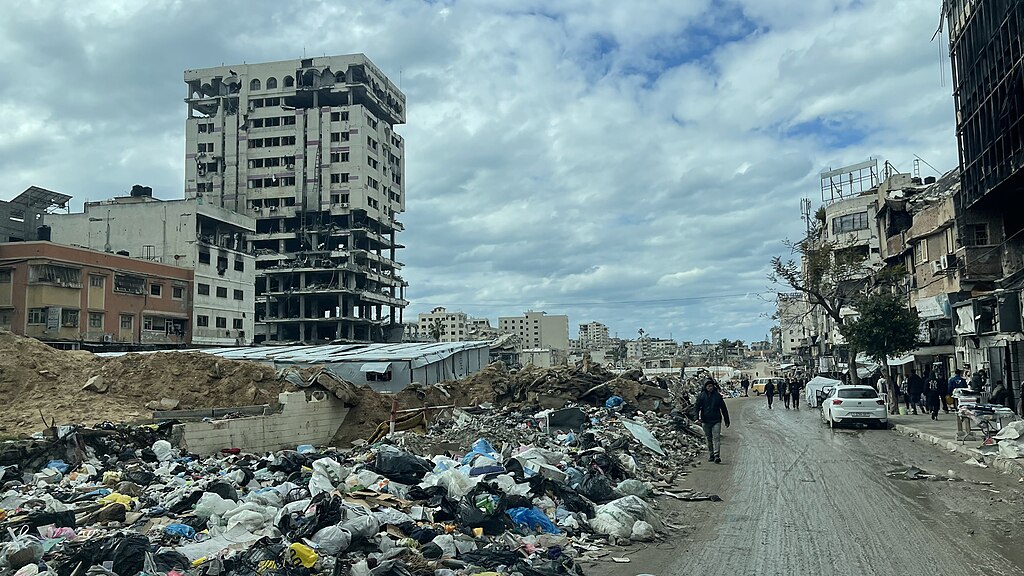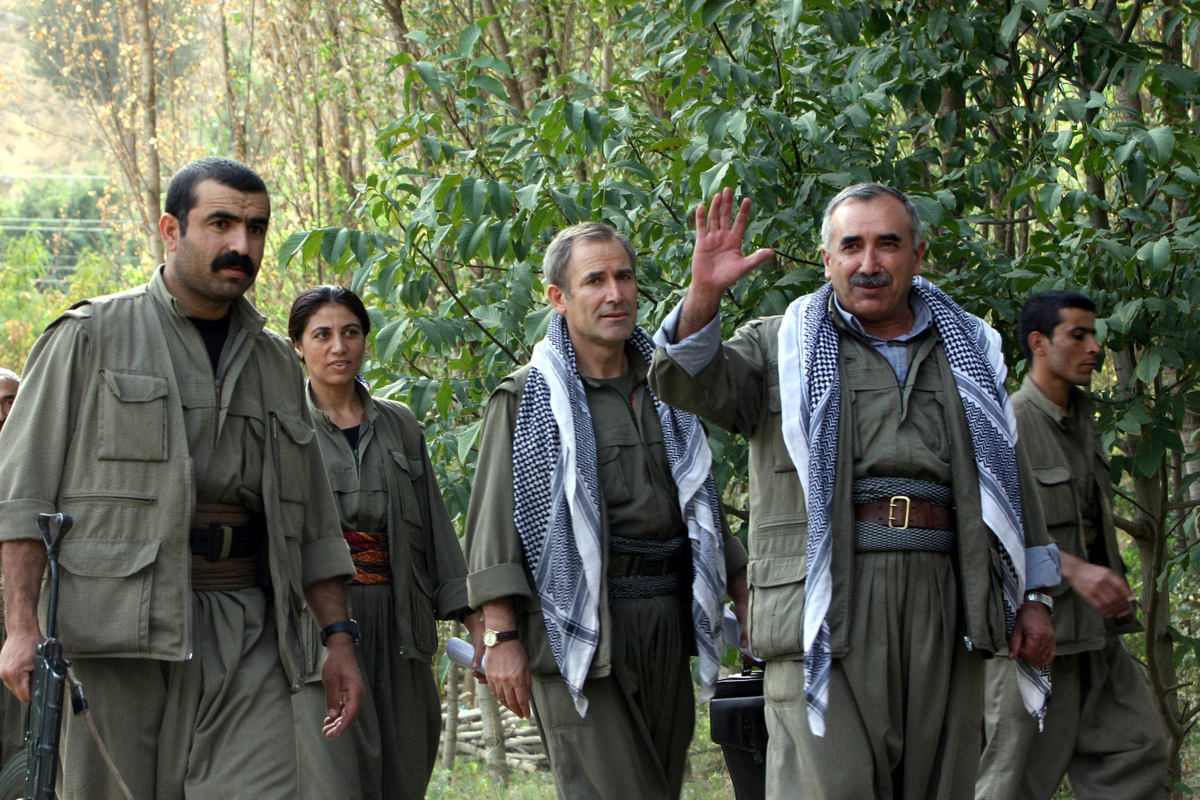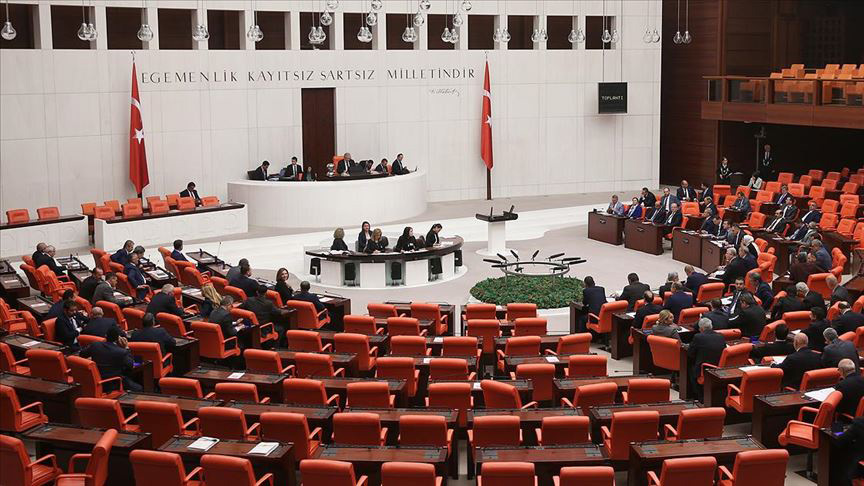Why the US-Brokered Gaza “Peace Plan” is Iraq 2.0: Disaster Capitalism in Full Effect

Omar Mukhtar Street in Gaza City, showing damage from Israeli bombing, February 23, 2025 | Picture Credits: Jaber Badwen/Wikimedia Commons
Omar Mukhtar Street in Gaza City, showing damage from Israeli bombing, February 23, 2025 | Picture Credits: Jaber Badwen/Wikimedia Commons
Donald Trump’s new ‘20-Point Gaza Peace Plan’ is being sold as a blueprint for stability after one of the most devastating wars in recent memory. Yet beneath its humanitarian veneer lies a familiar pattern. Like Iraq in 2003, Gaza is being remade not for the liberation of its people but for the liberation of capital. The formula is simple: destroy, destabilise, then rebuild under external management. Profit replaces accountability; control substitutes sovereignty.
Drawing on the precedents of post-2003 Iraq, the plan exposes how Orientalist narratives, the bypassing of international law, and the privatisation of recovery convert catastrophe into commerce. The United States (US), having supplied over $21.7 billion in military aid to Israel during the Gaza war, now stands ready to profit from reconstruction. Gaza, in effect, is Iraq 2.0: a neoliberal laboratory built on ruins.
Orientalism and the Permission to Destroy
In both Iraq and Gaza, gross violations of international law were ideologically licensed. Western narratives cast the Arab world as a space requiring discipline or ‘creative destruction.’ Orientalism, conceptualized by Edward Said as the framing of the East as irrational and backward, became the moral grammar of the “War on Terror.” Iraq was not merely invaded but imagined anew. As Thomas Friedman wrote at the time, “We are not doing nation-building in Iraq. We are doing nation-creating.”
The 1991 Gulf War saw about 300 Tomahawk missiles launched over five weeks; in 2003, – fuelled by the intense orientalist narratives – more than 380 in a single day, and over 20,000 precision munitions within six weeks – roughly 70 percent of the world’s stock at the time. The Pentagon’s Harlan Ullman, calling the approach ‘shock and awe’, claimed that it achieved in minutes what Hiroshima had done in weeks.
The same rationale governs Gaza. Since October 2023, more than 85,000 tonnes of explosives have been dropped on Gaza – more than the combined tonnage dropped on Dresden, Hamburg, and London in WWII combined – destroying schools, hospitals, and infrastructure. The UN calls Gaza ‘one of the most destroyed places on earth.’ As in Iraq, Orientalist dehumanisation made such devastation morally permissible and made international law optional, and in most cases, inapplicable to such groups of people.
Lawlessness as Method: The Iraq Prototype
Even “democracy-building” was outsourced: a North Carolina firm, Research Triangle Institute, received $466 million to design local councils – its president boasting Iraqis would one day build him a statue as their ‘founder of democracy.’
The US occupation of Iraq generated not only destruction but also a deliberate legal void. The Coalition Provisional Authority (CPA), led by Paul Bremer, ruled by decree and issued more than one hundred imperial orders that rewired Iraq’s political economy in violation of the Geneva and Hague Conventions. Order 12 suspended tariffs; Order 39 opened all sectors to foreign ownership; Order 17 granted contractors’ immunity from Iraqi law.
War was converted into a business model. Halliburton, Bechtel, and Parsons received billions via no-bid reconstruction contracts. Oversight mechanisms were minimal. The US Office of the Special Inspector General for Iraq Reconstruction found that $8.7 billion in taxpayer funds allocated to the Department of Defence simply vanished. Even “democracy-building” was outsourced: a North Carolina firm, Research Triangle Institute, received $466 million to design local councils – its president boasting Iraqis would one day build him a statue as their ‘founder of democracy.’
Iraq became a laboratory for the ‘Shock Doctrine,’ coined by Naomi Klein, wherein crises are exploited to impose neoliberal restructuring. Public assets were dismantled, the middle class hollowed out, unemployment soared, and corruption became systemic. The country was not rebuilt—it was privatised.
Gaza as the New Frontier
Fast-forward two decades, and the Gaza ‘peace plan’ follows a similar architecture. Framed as an effort to ‘stabilise’ and ‘modernise’ Gaza after the war, the plan assigns reconstruction to a proposed Gaza International Transition Authority, overseen by ‘international partners.’ It promises billions in aid, infrastructure development, and investment zones. But the details, – contained in leaked drafts and summit communications, reveal a structure of control, not liberation.
Funds are to be channelled through the World Bank’s ‘Palestinian Fund for Reconstruction and Development’ (PFRD), a multi-donor trust fund to ‘strengthen sustainable recovery and reconstruction, economic recovery and social resilience in the West Bank and Gaza.’ On paper, it aggregates donor contributions for coordination; in practice, leaked proposals and emerging governance structures suggest decision-making may be concentrated in donor capitals, potentially sidelining Palestinian institutions. While no public contract allocations have yet been approved, the obvious concern is that rebuilding contracts will favour large foreign firms, relegating Palestinian representatives to subordinate roles rather than allowing them to act with sovereign agency. The same architecture was deployed in Iraq after 2003, when the US-led CPA retained full control over reconstruction and policy, while legitimacy was projected through a hand-picked yet powerless Iraqi Governing Council – an elite face that masked the exclusion of genuine Iraqi sovereignty.
Francesca Albanese, the UN Special Rapporteur on the Occupied Territories, calls it an ‘economy of genocide’…
The UN Human Rights Council report (A/HRC/59/23) and press briefings from Geneva in late 2025 warn that reconstruction risks entrenching the ‘economy of occupation.’ Francesca Albanese, the UN Special Rapporteur on the Occupied Territories, calls it an ‘economy of genocide,’ noting how corporate entities have profited from the Israeli economies of illegal occupation, apartheid, and genocide. Her July 2025 report details how global corporations from arms manufacturers to logistics firms stand to profit from both the bombardment and the rebuilding that follows. As The Guardian revealed in September 2025, leaked documents outlining the so-called ‘Gaza Riviera’ project – an ambitious plan for luxury coastal redevelopment – were described by diplomats and aid officials as an attempt to cover ‘ethnic cleansing’ under the guise of reconstruction, further underscoring how post-war rebuilding is being framed as an economic opportunity rather than a process of justice or restitution. The humanitarian language of the plan masks a deeper continuity; Gaza’s future will be determined by the same transnational elite that armed its destruction.
From Shock to Stock: The Mechanics of Disaster Capitalism
Naomi Klein’s model unfolds in five stages – destruction, suspension of law, rapid privatisation, financialisation, and dependency. Iraq was the prototype; Gaza is the sequel. Massive bombardment renders local institutions unviable, emergency frameworks override sovereignty, and reconstruction is outsourced to foreign corporations. Donor funds and multilateral banks institutionalise control, ensuring long-term dependency.
Under current proposals, Gaza’s ports, power grids, and industrial zones will be rebuilt through public-private partnerships financed by donor states and managed abroad. Palestinian labour will remain cheap, oversight minimal, and sovereignty constrained. The language of peace hides an upward redistribution of power. Each rebuilt structure becomes a monument to dependency– a peace that commodifies recovery and freezes conflict in economic form.
Assange and the Business of Perpetual War
Julian Assange diagnosed this dynamic over a decade ago: “the goal is not to completely subjugate Afghanistan; the goal is to use Afghanistan to wash money out of the taxpayers of the United States, out of the taxpayers of the European countries, through Afghanistan and back to the hands of the transnational security elite.” War becomes a self-sustaining economic system that legally—and with a constructed, legitimate reason—transforms public expenditure into private profit.
Gaza fits the pattern. Western arms manufacturers profited from supplying Israel; reconstruction will hand contracts to the same constellation of firms, now rebranded as ‘humanitarian partners.’ The flow of money never stops – it simply changes direction. Halliburton epitomised this loop in Iraq, receiving $39.5 billion in contracts, most without bidding, while its former CEO, the then US Vice-President Dick Cheney, retained financial interests. War and reconstruction thus merged into a continuous enterprise of accumulation.
Yet Halliburton was merely the tip of the iceberg, as I examined in Elite Theory and the 2003 Iraq Occupation by the United States, these networks were far more extensive and deeply enmeshed, linking political elites, private contractors, and transnational financial institutions in a mutually reinforcing web of power. The moral economy was thus inverted: those complicit in destruction were empowered to rebuild, ensuring that violence continued to generate value long after the fighting ceased.
The Technocratic Occupation
What emerges is a technocratic occupation–governance by accountants and consultants who claim neutrality while entrenching external control. After 2003, Paul Bremer’s CPA justified its decrees as “modernisation” and “efficiency,” dismantling Iraqi sovereignty in the name of reform.
Gaza’s emerging reconstruction architecture follows a similar logic. The Trump-era and subsequent US-brokered ‘peace’ frameworks emphasise international supervision, foreign oversight, and technocratic administration–terms that appear benign but form the legal scaffolding of dependency. The World Bank’s newly restructured PFRD, adapted from its earlier trust fund, channels donor resources through fiduciary rules that empower external auditors and procurement boards rather than Palestinian representatives or institutions. The very fact that figures such as Tony Blair, who previously served as envoy for the Quartet and was closely associated with Iraq’s post-invasion privatisation agenda, are once again mentioned among prospective advisors and facilitators is testament to the enduring entanglement of political elites within these supposedly technocratic processes. This governance model echoes the CPA’s command economy, in which every major contract, policy, and priority was decided abroad and implemented locally by appointed elites.
This is control through bureaucracy rather than soldiers – a more subtle but no less coercive form of occupation.
Bomb, Rebuild, Repeat
Both Iraq and Gaza reveal a grim continuum: destruction followed by profitable reconstruction. Western powers supply the bombs, then lead the rebuilding, while locals bear the human cost.
Both Iraq and Gaza reveal a grim continuum: destruction followed by profitable reconstruction. Western powers supply the bombs, then lead the rebuilding, while locals bear the human cost.
Two decades after ‘Operation Iraqi Freedom,’ Iraq remains scarred by reforms that promised modernisation but delivered decay. Despite $138 billion in US reconstruction spending, few lasting assets were created. Corruption became endemic; unemployment soared. Iraq was not rebuilt; it was commodified.
Conditional and Hollow: Palestinian Statehood Promise
Gaza risks the same fate. The proposed reconstruction authority and World Bank mechanisms may operate as tools of colonial administration, funnelling foreign capital through elite networks while sidelining Palestinian civil society. The cycle ensures that every act of destruction becomes a prelude to investment.
The moral paradox is striking: the same states that supplied the weapons now present themselves as saviours. Each phase of the cycle–war and reconstruction–produces profit for the same groups of actors. The rhetoric of compassion obscures the arithmetic of control. Rebuilding thus becomes an act of moral laundering–the transformation of culpability into investment. Trump’s visit to Israel, culminating in his address to the Knesset and the subsequent Sharm el-Sheikh summit, encapsulated this choreography of moral show-business; a carefully staged sequence in which humanitarian language and diplomatic ceremony masked the conversion of war into economic opportunity. Beneath the optics of peace, the same networks of power and profit remained firmly in place.
The plan’s promise of Palestinian statehood is conditional and hollow – sovereignty filtered through donor oversight and perpetual probation. True reconstruction requires restitution and Palestinian ownership, not another round of externally managed dependency.
Continuity as Core Logic
The US-brokered Gaza “peace plan” is not an anomaly but a continuation–Orientalism as justification, lawlessness as method, and privatisation as reward. It confirms that modern wars are waged less for territory than for markets, sustained by profitable instability. Even peace has been financialised; reconstruction without restitution, oversight without sovereignty, compassion without justice.
Unless the world insists on a rights-based, Palestinian-led process, Gaza will mirror Iraq – a land rebuilt for outsiders, where dependency is the only lasting structure, and the ruins themselves become assets.
Assange’s insight that war is not fought for victory but for continuity–for the endless circulation of capital between states, corporations, and elites may ring truer and more relevant than previously thought.
Bamo Nouri
Bamo Nouri is an award-winning senior lecturer in International Relations at the University of West London, an Honorary Research Fellow at City St George’s, University of London, and a One Young World Ambassador. He is also an independent investigative journalist and writer with interests in American foreign policy and the international and domestic politics of the Middle East. He is the author of Elite Theory and the 2003 Iraq Occupation by the United States.



